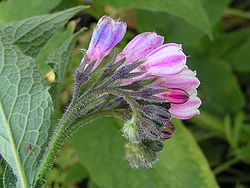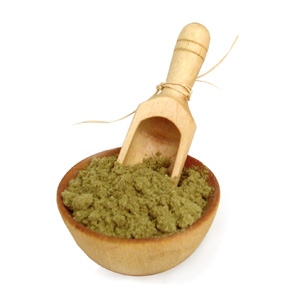Four years ago — mostly from curiosity, because we'd heard so much about the plant's virtues — we set aside a small rectangular spot on our acre for a bed of 30 comfrey cuttings. They grew like mad. We harvested comfrey leaves all summer, and found so many uses for comfrey that, at the end of the
season, we ordered 150 additional roots and expanded our little patch to a plantation of 200.
In case you're not familiar with comfrey (Symphytum officinale), it's a member of the borage family, a strong-growing perennial with somewhat hairy leaves 12 to 18 inches long, rising on short stems from a central crown. The flower is a pretty blue bell, fading to pink. We don't wait to see the blossoms, however, because the foliage is at its best if cut before blooming time. The plant reaches a height of over two feet and spreads to more than a yard across, but — since comfrey doesn't throw out creeping roots and hardly ever sets seed — it's remarkably non-invasive for such a sturdy being.
Comfrey leaves have a high moisture content and dry more slowly than some of the herbs you may be used to working with. Just give them a little extra time. Make sure the leaves are crumbly before you store them, though, since any remaining dampness will cause mold. Then pack the foliage into jars and close the containers tightly.
Medicinal Uses for Comfrey
Comfrey has long been used as a cure by Gypsies and peasant peoples, and has an ancient reputation as a mender of broken bones. In her marvelous book Herbal Healing for Farm and Stable, Juliette de Bairacli also recommends it for uterine and other internal hemorrhages and for the healing of wounds. British Gypsies, she writes, feed the roots to their animals as a spring tonic. (Please Note: Comfrey is toxic to the liver for both humans and livestock and should not be taken orally or used on open wounds. —MOTHER.)
Comfrey contains allantoin, a substance known to aid granulation and cell formation . . . which is what the healing process is all about. The effectiveness of this valuable plant can now be accounted for, and is therefore more widely accepted. (Funny how pinning a name on the curative property makes it possible for us to acknowledge it!) Here on our acre, we follow Mrs. Levy's advice and treat both people and animal hurts with comfrey. Generally we use an infusion (strong tea) of fresh or dried leaves, either to soak a part such as a sore finger or to dab on a cut with cotton. Crushed foliage can be applied externally, or a raw leaf rubbed on skin lesions such as rashes and poison ivy blisters. (Scratch and heal in one operation!) Comfrey should not be applied to open wounds or broken skin.
The most common medicinal use of comfrey are in poultices to help heal swellings, inflammations and sores. To make such a dressing, let the leaves mush up in hot water, squeeze out the excess liquid and wrap several handfuls of the hot, softened foliage in a clean cloth. Apply the pad to the affected part—comfortably hot, but not scalding—and cover the area with a thick folded towel to keep the heat in. The moist warmth enhances the healing effect of the allantoin.......
:)


No comments:
Post a Comment